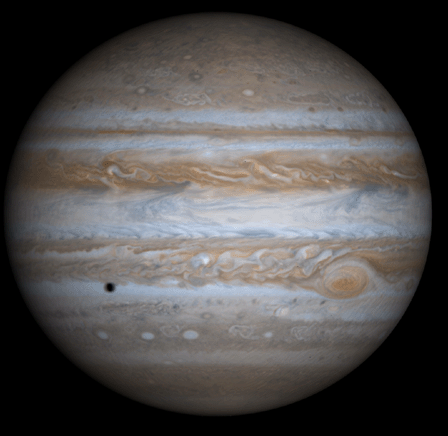 |
(To left, from the Galileo Project, http://www.jpl.nasa.gov/pictures/jupiter/ above, an Indian miniature painting of Brihaspati, the planet Jupiter, divine sage and tutor of the Gods, from The Black Peacock, http://www.goloka.com/index.html) |
Key points: "Weather" features; internal energy; nature of surface; interior composition; contrast of a giant planet with the terrestrial ones
Jupiter is the largest planet in the Solar System (as massive as all the rest together). It is a "giant planet," with very different properties from the "terrestrial" planets we have studied so far.
 |
(To left, from the Galileo Project, http://www.jpl.nasa.gov/pictures/jupiter/ above, an Indian miniature painting of Brihaspati, the planet Jupiter, divine sage and tutor of the Gods, from The Black Peacock, http://www.goloka.com/index.html) |
Important characteristics of giant planets are:
Their average densities are low, similar to water: Jupiter is 1.3 grams/cm3 and Saturn is 0.7 grams/cm3 - compared with densities of 3 - 6 grams/cm3 for terrestrial planets.
Their composition is similar to Sun -- (especially Jupiter and Saturn)
whereas the terrestrial planets are made almost entirely of those "other elements."
They have liquid or icy surfaces and dense atmospheres with violent and long lasting storms.
 |
Jupiter rotates in 9 hr 50 minutes at its equator. However, careful observation shows that the rotational rate is slower moving towards the pole -- 9 hr 56 minutes. |
Differential rotation implies that we are not seeing a solid surface, which would have to have a constant rotational speed.
The inner terrestrial planets have a close balance between the energy absorbed from the sun and the energy radiated into space.
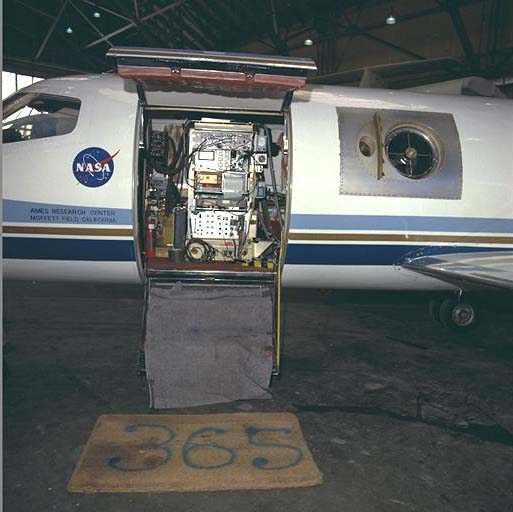 |
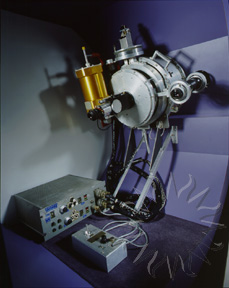 |
To observe in the far infrared, in 1969 a 12 inch telescope was mounted in the escape hatch of a Lear Jet so it could be carried above most of the atmosphere (which absorbs far infrared light) (from http://www.nasm.si.edu/research/dsh/artifacts/SS-LearJetScope.htm). It was discovered that Jupiter emits twice as much energy as it absorbs from the sun. Subsequently, it was found that Saturn and Neptune (but not Uranus) also emit about twice as much energy as they absorb from the sun.
For Jupiter, this can be trapped heat from the time of its formation; the cause is not well understood for Saturn and Neptune.
| Jupiter has the strongest magnetic field of any body in the solar system. The magnetic field on Jupiter implies that it must contain a liquid metal which contradicts expectations from its density. However, at a depth of ~15,000 km below its cloud tops, the pressure becomes so great that hydrogen becomes a liquid metal (a rarity because both temperature and pressure must be very high). "Metallic" in this sense means it conducts electricity readily. Most of the interior of Jupiter is in this state. (http://www2.jpl.nasa.gov/galileo/jupiter/interior.html) | 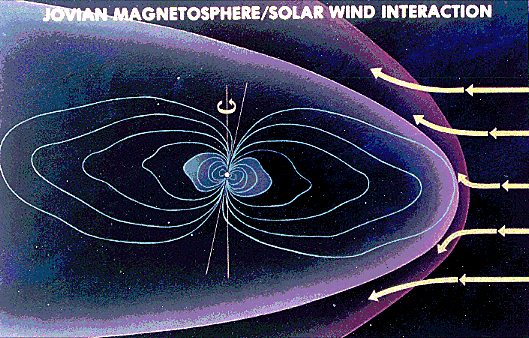 |
|
Jupiter also has aurorae similar to those on Earth. (http://nssdc.gsfc.nasa.gov/ photo_gallery/photogallery-jupiter.html) |
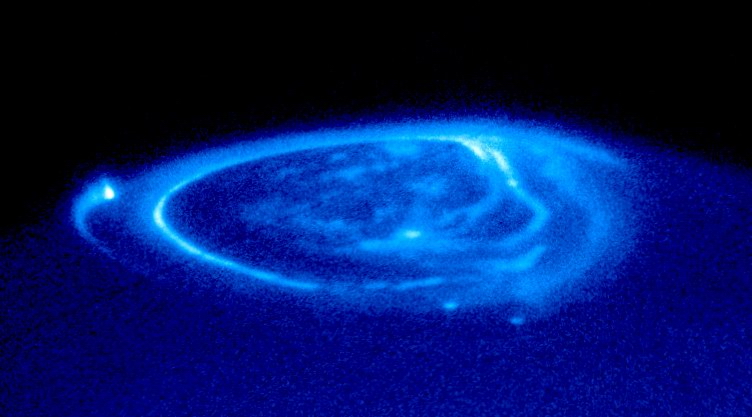 |
Not long after the Galileo mission arrived at Jupiter, a probe that fell through the atmosphere was released. As the probe fell, it returned data on temperature, pressure, composition, wind speeds, and prevalence of clouds. These results showed that
Exactly how giant planets form quickly, before the gas escapes from protoplanetary disks, is a problem we are still struggling to understand.
Therefore, the interior structure of the planet is as shown to the right. In place of the molten rock mantle of Earth, Jupiter has a thick layer of liquid hydrogen. Far below this liquid hydrogen "mantle" the pressure is so great that the hydrogen changes state to become electrically conductive. The strong magnetic field is a product of the rapid rotation and this conductive layer. We suspect that the rocky materials have settled into a core not too different in size than the earth, but dwarfed in this case by the overlying layers of hydrogen and helium. (from Nick Strobel's Astronomy Notes. From www.astronomynotes.com) |
 |
| We do not believe Jupiter has any solid surface (despite what you may have seen in the movies!). Instead, the "surface" is probably liquid molecular hydrogen under great pressure from the thick atmosphere. Perhaps it would look like this artist's concept! |  |
Test your understanding before going on![]()
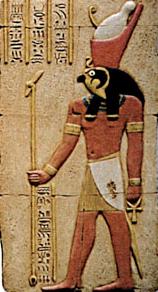 Horus,
Egyptian god of Mars, http://grenier2clio.free.fr/egypte/horus.htm Horus,
Egyptian god of Mars, http://grenier2clio.free.fr/egypte/horus.htm |
Shani, Vedic god of Saturn, http://www.payer.de/kommkulturen/kultur123.htm |
|
Click to return to syllabus |
||
| Click to return to Mars | hypertext |
Click to go to Saturn, Uranus, and Neptune |